Intel’s newest processors might not be the future, but they’re definitely future-ready.
Don’t worry: The company’s 12th-generation Alder Lake processors are a big step up from the previous generation. Of course, the previous generation was the fifth generation built on Intel’s six-year-old 14nm node, and offered modest gen-over-gen performance gains and an Intel-typical single-core lead over AMD — not bad, but not worth taking apart your PC for.
But there’s more to computing than just speed, frame rates, and power (not really, but we’ll get to performance in a moment). Future-proofing and upgradeability are also key factors. Intel’s 12th-gen processors support the next-gen component standards you don’t yet know you need, like DDR5 RAM, PCIe Gen 5, Thunderbolt 4, and WiFi 6e.
If you’ve been waiting for a real generation switch to upgrade from a 9th- or 10th-gen processor, this is your moment.

Intel Core i9-12900K and Core i5-12600K
What is it?
Intel's 12th-gen desktop CPUs built on new hybrid architecture
Price
$US289 ($389) for the Core i5-12600K; $US589 ($794) for the Core i9-12900K
Like
Great multi-core performance due to lots of cores; first processors to support DDR5; i5-12600K offers great performance for price
Don't like
A pretty expensive upgrade that requires more hardware; the i9-12900K runs hot at base speed, and anyone buying an i9 is probably looking to push performance
Upgrading won’t come particularly cheap, though. The 12th-gen processors have a new socket — LGA 1700 — so you’ll need a new motherboard. Motherboards will have either DDR4-compatible slots or DDR5-compatible slots, not both, so you may need to pick up some DDR5 RAM. Also, the new processors are rectangular instead of square, so your heatsink may require an upgrade (or at least a compatibility kit from the manufacturer).
Finally, 12th-gen processors are pricier than their 11th-gen counterparts: $US289 ($389) for the Core i5-12600K and $US589 ($794) for the Core i9-12900K, compared to $US259 ($349) for the Core i5-11600K and $US539 ($726) for the Core i9-11900K.
I tested Intel’s 12th-gen processors in the following build: MSI MPG Z690 Carbon WiFi motherboard, Nvidia GeForce RTX 2070 GPU, SK Hynix 64GB (2 x 32GB) DDR5-4800 RAM, Samsung 970 EVO Plus NVMe M.2 SSD 1TB, Seasonic Focus GX-850 PSU, and a Corsair iCUE H150i Elite Capellix 360mm cooler with eight 120mm fans. I also benchmarked Intel’s 11th-gen i7-11700K, using an ASUS ROG Maximus XIII Hero Z590 motherboard and Team T-FORCE Vulcan Z 16GB (2 x 8GB) DDR4-3200 RAM.
My build is different from Gizmodo’s most recent past benchmarking configuration, the notable difference being the graphics card (the GPU shortage has affected me, too!), which is something to keep in mind for gaming and graphics-heavy benchmarks. I’ll be using the benchmark scores for the Intel Core i5-11600K, Core i9-11900K, and AMD Ryzen 9 5950X from our 11th-gen processor review, so keep in mind these aren’t as direct a comparison as we would prefer.
Catching Up to AMD

Intel’s 12th-gen processors are built on a hybrid architecture. They have a mix of performance cores (P-cores) for powerful, single-core tasks, and efficiency cores (E-cores) for background tasks and multitasking. Hybrid chips are definitely not new; you’ve been able to snag Arm hybrids for a while (like Apple’s M1 SoC). Intel’s hybrid processors also come bundled with Intel’s Thread Director, a hardware-based taskmaster that directs tasks to different cores for speedier, more efficient processing. Thread Director is built into the hardware but it’s designed to work alongside Windows 11. I benchmarked with both Windows 10 and Windows 11 and didn’t see any significant differences between the two, so you don’t need Windows 11 to get a performance boost.
Intel usually beats AMD in single-core performance, because Intel’s chips have higher clock speeds. The Core i9-12900K has 16 cores (8 P-cores and 8 E-cores), 24 threads, and can get up to 5.2GHz. This is lower than the Core i9-11900K’s top speed of 5.3GHz and higher than the AMD Ryzen 5950X’s top speed of 4.9GHz, so perhaps it’s not too surprising that the i9-12900K’s single-core score in Geekbench 5 is 1961 — right between the two. The Core i5-12600K offers better performance, both gen-over-gen and for the price, with a single-core score of 1863, which puts it solidly ahead of the Ryzen 9 5950X and both the 11th-gen Core i5-11600K and the Core i7-11700K. The i5-12600K has 10 cores (6 P-cores and 4 E-cores), 16 threads, and a top speed of 4.9GHz.
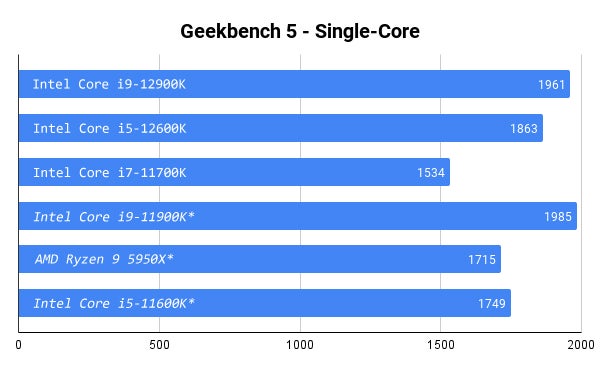
Multi-core performance is where Intel has lagged behind AMD in the past, because the most important factor in multi-core performance is having multiple cores. But thanks to the new hybrid architecture, Intel has tons of cores — or, well, the Core i9-12900K has 16 cores to the Ryzen 9 5950X’s 16 cores (both have twice as many as the Core i9-11900K’s 8 cores). The Core i5-12600K has 10 cores compared to the Core i5-11600K’s 6 cores.
In our past benchmarks, the Ryzen 9 5950X put up an impressive multi-core score of 14158, leagues ahead of the Core i9-11900K’s score of 10656. Well, Intel’s Thread Director must be doing its job of optimising core efficiency, because the Core i9-12900K put up a very impressive multi-core score of 18400. And the Core i5-12600K may only have 10 cores, but it’s hot on AMD’s tail with a multi-core score of 13154.
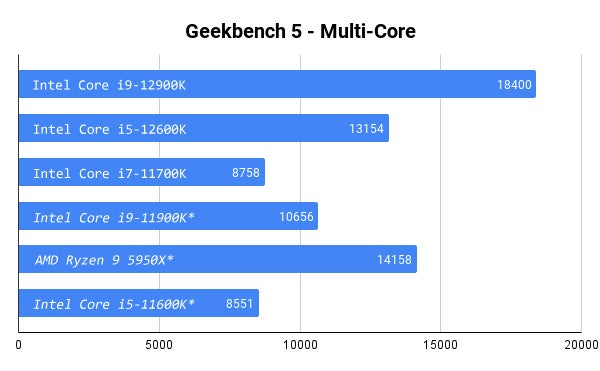
I also ran Handbrake, which tests how quickly the system transcodes a 4K video file into 1080p at 30fps. Video rendering and transcoding is heavily dependent on the graphics card, but it definitely benefits from a multi-core, multi-threaded CPU, especially if those cores are being used efficiently. (Using multiple cores efficiently is usually a software-side issue — if Thread Director can optimise on the hardware side, that might be a game-changer.) The Core i9-12900K sped through the Handbrake test, transcoding the 4K clip to 1080p in three minutes and 21 seconds (201 seconds), easily eclipsing the 11th-gen despite my older RTX 2070 GPU.
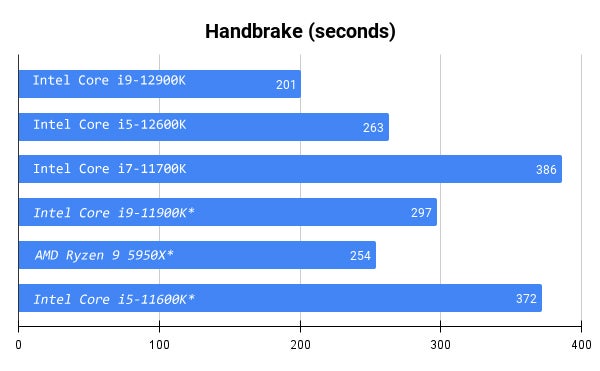
The Core i5-12600K also performed admirably on the Handbrake test, transcoding the clip in four minutes and 23 seconds (263 seconds), which puts it just below the Ryzen 9 5950X’s time (254 seconds). The Core i5-12600K isn’t exactly blowing AMD’s processors out of the water, but it’s definitely holding its own — remember, the Core i5-12600K has 10 cores and 16 threads to the Ryzen 9 5950X’s 16 cores and 32 threads, and is about a third of the price. The Intel processors do benefit from the bump up in RAM, but at the moment these Intel processors are the only processors on the market that support DDR5 so… your move, AMD.
A Very Good Gaming CPU

When it comes to gaming, especially graphics-intensive games, it’s really the graphics card and not the CPU that makes a noticeable difference. Intel keeps touting its Core i9-12900K as the best gaming processor, and it is an excellent gaming processor, but the Core i5-12600K is also pretty impressive. The Core i9-12900K showed off an average framerate of 329fps in our Overwatch benchmark; the Core i5-12600K averaged 319fps in the same test (for comparison, the 11th-gen Core i7-11700K averaged 308fps).
The numbers were even closer in Civilisation VI: The Core i9-12900K performed the Civ VI graphics test with an average of 6.824ms, while the Core i5-12600K performed the same test and averaged 6.86ms. In the Civ VI AI benchmark, which tests how quickly the system performs a series of AI-directed tasks in one “turn,” the Core i9-12900K took 7.25 seconds to complete one turn, while the Core i5-12600K took 7.29 seconds — not even a 0.05-second difference. Just for fun, and to emphasise how much of a difference the graphics card makes, I went ahead and ran the Civ VI benchmarks with Intel’s integrated UHD 770 graphics. The numbers weren’t great — I don’t think the majority of people buying an i9 plan on sticking with the chip’s onboard graphics, so whatever — but they were still pretty close. In the graphics test the Core i9-12900K took 80.167ms on average while the Core i5-12600K took 87.365ms; in the AI test the i9 averaged 15.77 seconds to the i5’s 16.42 seconds.
Frame rates also didn’t differ noticeably in Shadow of the Tomb Raider, which isn’t too surprising, since Shadow of the Tomb Raider is definitely GPU-bound. The Core i9-12900K offered a slight frame rate increase over the 11th-gen Core i7-11700K, but only by a handful of frames per second — we’re talking 10fps or so, which is nothing compared to the increase you’ll see with a better graphics card.
Benchmarks aside, two of my favourite games, The Elder Scrolls Online and No Man’s Sky, are incredibly CPU-intensive. The Elder Scrolls Online is an MMO and I think the installer alone is almost 100GB; No Man’s Sky features an infinite, procedurally-generated universe that heavily taxes just about every aspect of your system. Both games played well on both of Intel’s 12th-gen processors, but I definitely saw a bump with the Core i9-12900K. The Core i9-12900K gave me such a noticeable performance boost in No Man’s Sky with smoother graphics and significantly quicker load times (those of you who’ve played No Man’s Sky know that about 50% of the game is just… waiting), that it might be worth the 17 additional case fans I’ll have to purchase to keep this processor at double-digit temperatures.
Questionable Energy Efficiency

According to Intel, its 12th-gen processors are thinner, cooler, and more energy-efficient. Both the Core i9-12900K and the Core i5-12600K have a base power draw of 125w. However, Intel’s self-reported gen-over-gen performance gains and benchmark leads are most impressive when the Core i9-12900K is set to a 241w power draw. I’m not surprised: The Core i9-12900K definitely runs hotter than I’d like and seems to want all the power. While I managed the Core i5-12600K just fine at an average resting temp of less than 22C, the Core i9-12900K was frequently over 31C. My case (a mid-tower Corsair iCUE 200 T) fits about five or six fans comfortably, and I ended up removing the front grill and strapping three extra fans to the outside of the radiator because the Core i9-12900K ran so hot.
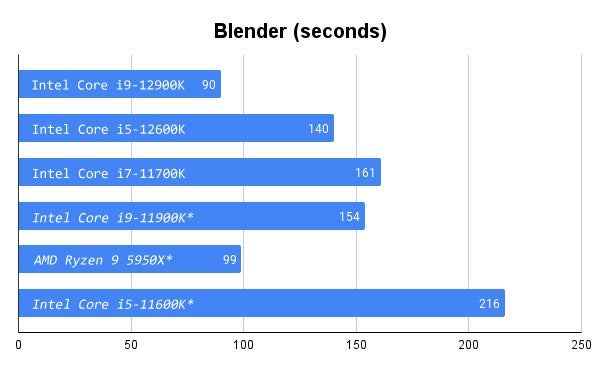
While the Core i5-12600K breezed through the Blender 3D image rendering test, completing the render in 140 seconds (speedier than all three of Intel’s 11th-gen processors), I was initially unable to get through even 70% of the Blender benchmark with the Core i9-12900K before my system shut down. It seems like it may have been a power draw issue, because I swapped in a couple of PSUs before I managed to finally complete the test with the Seasonic Focus GX-850. The Core i9-12900K completed the render in 90 seconds — quicker than the Ryzen 9 5950X’s impressive 99-second time — but it ran dangerously hot the entire time, averaging 96C and going as high as 101C.
Worth Upgrading?
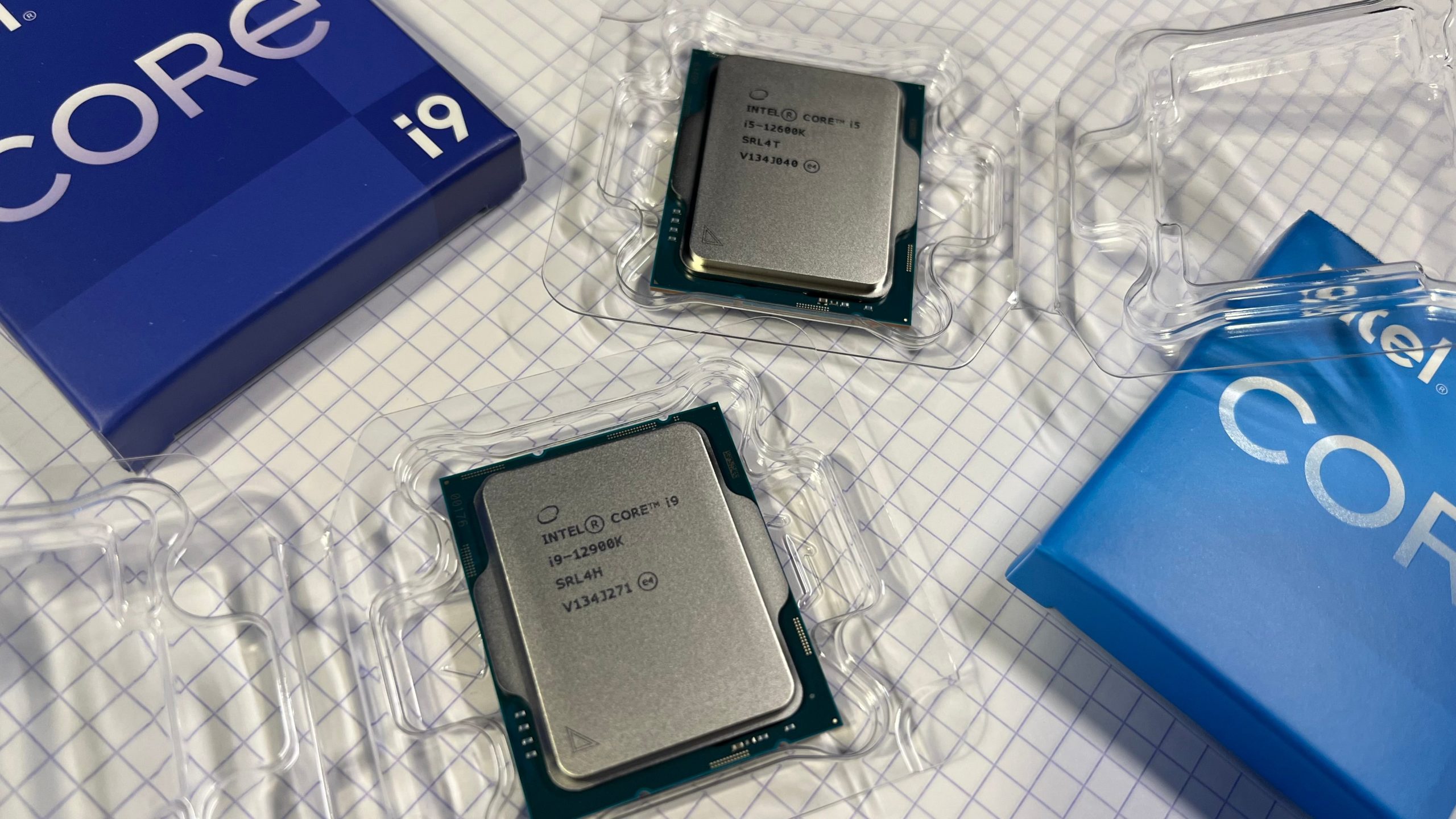
Intel’s 12th-gen processors are definitely looking to the future, but they’re not quite there yet. Alder Lake is Intel’s first generation of desktop processors fabricated on a 10nm node — which is, confusingly, called the Intel 7 process — and Intel’s 7nm process (called Intel 4) has already been delayed until late 2022, possibly 2023. By the time Intel gets to 7nm, fellow chip manufacturer TSMC will be on 3nm, which means Intel will probably spend some time catching up.
But if you’ve been waiting to upgrade, this is a good time to do it. I can’t promise that the Z690 chipset will last through your next upgrade (look at how quickly Intel ditched the LGA 1200 socket), but the new component standards, like DDR5, PCIe Gen 5, WiFi 6e, will probably endure (or be backwards-compatible) through a couple of generations. The Core i9-12900K is definitely an excellent gaming processor, but it’s the Core i5-12600K that impresses with its sub-$US300 ($404) price tag, fantastic single- and multi-core performance, and low system load.
